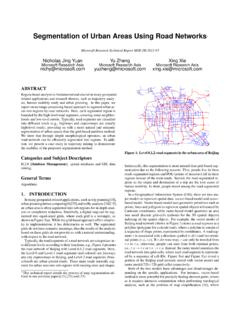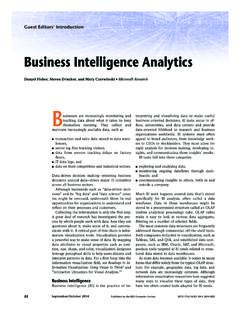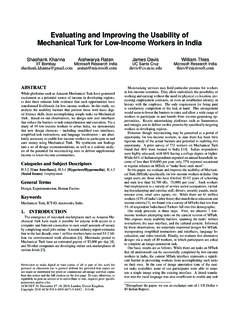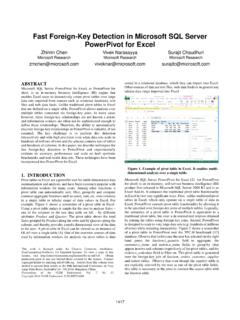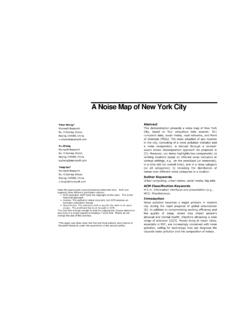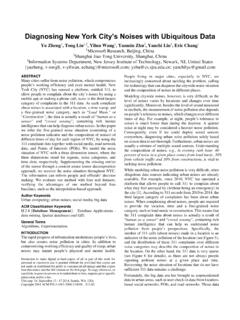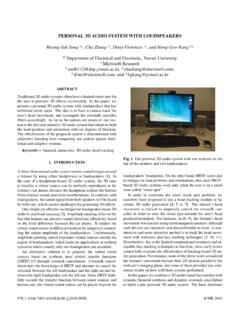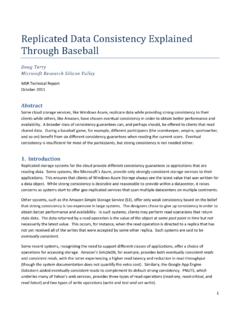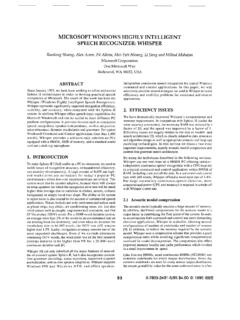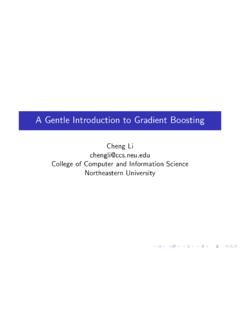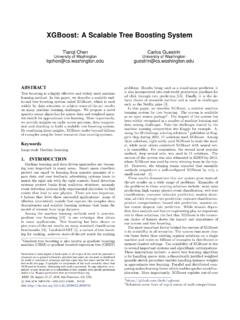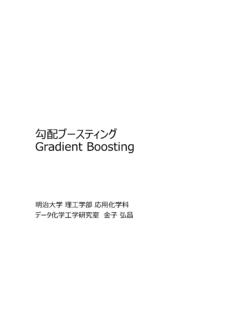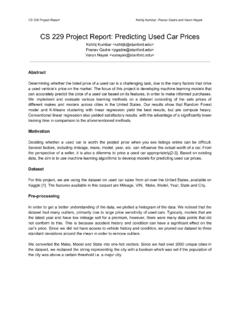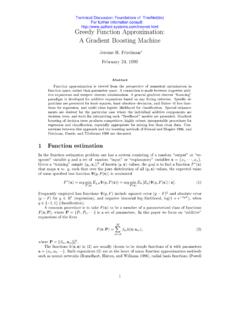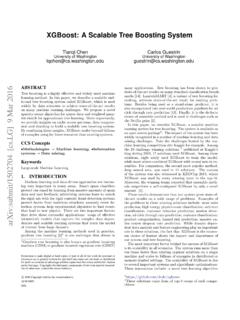Transcription of LightGBM: A Highly Efficient Gradient Boosting Decision …
1 LightGBM: A Highly Efficient Gradient BoostingDecision TreeGuolin Ke1, Qi Meng2, Thomas Finley3, Taifeng Wang1,Wei Chen1, Weidong Ma1, Qiwei Ye1, Tie-Yan Liu11 Microsoft Research2 Peking University3 Microsoft Redmond1{ , taifengw, wche, weima, qiwye, Boosting Decision Tree (GBDT) is a popular machine learning algo-rithm, and has quite a few effective implementations such as XGBoost and many engineering optimizations have been adopted in these implemen-tations, the efficiency and scalability are still unsatisfactory when the featuredimension is high and data size is large. A major reason is that for each feature,they need to scan all the data instances to estimate the information gain of allpossible split points, which is very time consuming. To tackle this problem, wepropose two novel techniques: Gradient -based One-Side Sampling(GOSS) andExclusive Feature Bundling(EFB).}
2 With GOSS, we exclude a significant propor-tion of data instances with small gradients, and only use the rest to estimate theinformation gain. We prove that, since the data instances with larger gradients playa more important role in the computation of information gain, GOSS can obtainquite accurate estimation of the information gain with a much smaller data EFB, we bundle mutually exclusive features ( , they rarely take nonzerovalues simultaneously), to reduce the number of features. We prove that findingthe optimal bundling of exclusive features is NP-hard, but a greedy algorithmcan achieve quite good approximation ratio (and thus can effectively reduce thenumber of features without hurting the accuracy of split point determination bymuch). We call our new GBDT implementation with GOSS and experiments on multiple public datasets show that, LightGBM speeds up thetraining process of conventional GBDT by up to over 20 times while achievingalmost the same IntroductionGradient Boosting Decision tree (GBDT) [1] is a widely-used machine learning algorithm, due toits efficiency, accuracy, and interpretability.
3 GBDT achieves state-of-the-art performances in manymachine learning tasks, such as multi-class classification [2], click prediction [3], and learning torank [4]. In recent years, with the emergence of big data (in terms of both the number of featuresand the number of instances), GBDT is facing new challenges, especially in the tradeoff betweenaccuracy and efficiency. Conventional implementations of GBDT need to, for every feature, scan allthe data instances to estimate the information gain of all the possible split points. Therefore, theircomputational complexities will be proportional to both the number of features and the number ofinstances. This makes these implementations very time consuming when handling big tackle this challenge, a straightforward idea is to reduce the number of data instances and thenumber of features.
4 However, this turns out to be Highly non-trivial. For example, it is unclear how toperform data sampling for GBDT. While there are some works that sample data according to theirweights to speed up the training process of Boosting [5,6,7], they cannot be directly applied to GBDT31st Conference on Neural Information Processing Systems (NIPS 2017), Long Beach, CA, there is no sample weight in GBDT at all. In this paper, we propose two novel techniquestowards this goal, as elaborated One-Side Sampling(GOSS). While there is no native weight for data instance inGBDT, we notice that data instances with different gradients play different roles in the computationof information gain. In particular, according to the definition of information gain, those instanceswith larger gradients1( , under-trained instances) will contribute more to the information , when down sampling the data instances, in order to retain the accuracy of information gainestimation, we should better keep those instances with large gradients ( , larger than a pre-definedthreshold, or among the top percentiles), and only randomly drop those instances with small prove that such a treatment can lead to a more accurate gain estimation than uniformly randomsampling, with the same target sampling rate, especially when the value of information gain has alarge Feature Bundling(EFB).
5 Usually in real applications, although there are a large numberof features, the feature space is quite sparse, which provides us a possibility of designing a nearlylossless approach to reduce the number of effective features. Specifically, in a sparse feature space,many features are (almost) exclusive, , they rarely take nonzero values simultaneously. Examplesinclude the one-hot features ( , one-hot word representation in text mining). We can safely bundlesuch exclusive features. To this end, we design an efficient algorithm by reducing the optimalbundling problem to a graph coloring problem (by taking features as vertices and adding edges forevery two features if they are not mutually exclusive), and solving it by a greedy algorithm with aconstant approximation call the new GBDT algorithm with GOSS and EFBL ightGBM2.
6 Our experiments on multiplepublic datasets show that LightGBM can accelerate the training process by up to over 20 times whileachieving almost the same remaining of this paper is organized as follows. At first, we review GBDT algorithms and relatedwork in Sec. 2. Then, we introduce the details of GOSS in Sec. 3 and EFB in Sec. 4. Our experimentsfor LightGBM on public datasets are presented in Sec. 5. Finally, we conclude the paper in Sec. GBDT and Its Complexity AnalysisGBDT is an ensemble model of Decision trees, which are trained in sequence [1]. In each iteration,GBDT learns the Decision trees by fitting the negative gradients (also known as residual errors).The main cost in GBDT lies in learning the Decision trees, and the most time-consuming part inlearning a Decision tree is to find the best split points.
7 One of the most popular algorithms to find splitpoints is the pre-sorted algorithm [8,9], which enumerates all possible split points on the pre-sortedfeature values. This algorithm is simple and can find the optimal split points, however, it is inefficientin both training speed and memory consumption. Another popular algorithm is the histogram-basedalgorithm [10,11,12], as shown in Alg. 13. Instead of finding the split points on the sorted featurevalues, histogram-based algorithm buckets continuous feature values into discrete bins and uses thesebins to construct feature histograms during training. Since the histogram-based algorithm is moreefficient in both memory consumption and training speed, we will develop our work on its shown in Alg. 1, the histogram-based algorithm finds the best split points based on the featurehistograms.
8 It costsO(#data #feature)for histogram building andO(#bin #feature)forsplit point finding. Since #bin is usually much smaller than #data, histogram building will dominatethe computational complexity. If we can reduce #data or #feature, we will be able to substantiallyspeed up the training of Related WorkThere have been quite a few implementations of GBDT in the literature, including XGBoost [13],pGBRT [14], scikit-learn [15], and gbm in R [16]4. Scikit-learn and gbm in R implements the pre-sorted algorithm, and pGBRT implements the histogram-based algorithm. XGBoost supports both1 When we say larger or smaller gradients in this paper, we refer to their absolute code is available at GitHub: to space restriction, high level pseudo code is used. The details could be found in our open-source are some other works speed up GBDT training via GPU [17,18], or parallel training [19].
9 However,they are out of the scope of this pre-sorted algorithm and histogram-based algorithm. As shown in [13], XGBoost outperformsthe other tools. So, we use XGBoost as our baseline in the experiment reduce the size of the training data, a common approach is to down sample the data instances. Forexample, in [5], data instances are filtered if their weights are smaller than a fixed threshold. SGB[20] uses a random subset to train the weak learners in every iteration. In [6], the sampling ratio aredynamically adjusted in the training progress. However, all these works except SGB [20] are basedon AdaBoost [21], and cannot be directly applied to GBDT since there are no native weights for datainstances in GBDT. Though SGB can be applied to GBDT, it usually hurts accuracy and thus it is nota desirable , to reduce the number of features, it is natural to filter weak features [22,23,7,24].
10 Thisis usually done by principle component analysis or projection pursuit. However, these approacheshighly rely on the assumption that features contain significant redundancy, which might not alwaysbe true in practice (features are usually designed with their unique contributions and removing any ofthem may affect the training accuracy to some degree).The large-scale datasets used in real applications are usually quite sparse. GBDT with the pre-sortedalgorithm can reduce the training cost by ignoring the features with zero values [13]. However,GBDT with the histogram-based algorithm does not have efficient sparse optimization solutions. Thereason is that the histogram-based algorithm needs to retrieve feature bin values (refer to Alg. 1) foreach data instance no matter the feature value is zero or not.
